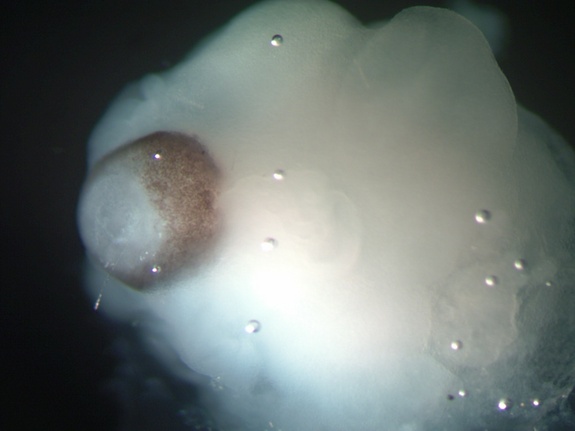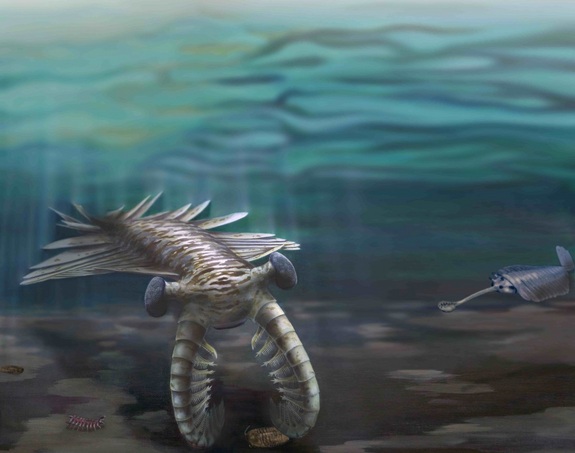The ethereal glow of the southern lights creates a spectacular show in the night sky over Antarctica in this photo. The southern lights (also known as aurora australis) are the southern hemisphere's counterparts to the northern lights. Both are triggered by charged particles from the solar wind interacting with the Earth's atmosphere. As these particles pass through Earth's magnetic shield and travel to the polar regions, they emit brief flashes of light as they mingle with the atoms and molecules in the atmosphere.
This photo was taken during a recent mission to Antarctica by scientists at the Alfred Wegener Institute for Polar and Marine Research. The expedition required 49 scientists and 44 crew members to live in Antarctica during the region's winter months, from June to August.

Sunday, September 15, 2013
Electricity In The Air At Glen Canyon Dam
Electricity was literally in the air at the Glen Canyon Dam when this photo was snapped.
The Glen Canyon Dam is a concrete arch dam on the Colorado River in northern Arizona that churns out hydroelectric power around the clock.
Construction began in 1956 for the purpose of providing power and water flow regulation from the upper Colorado River Basin to the lower. The dam is a 710-foot-tall (216 meter) structure with a crest length of 1,560 feet (475 m). (The crest length is the length across the dam from one abutment to another, with the abutment being the part of the dam that sits against the riverbank.) The dam is 25 feet (7.6 m) thick at the crest and up to 300 feet (91 m) thick at the base.
The Glen Canyon Dam reservoir is Lake Powell, the second largest artificial lake in the country, which stretches upriver into Utah. The lake is one of the most popular houseboating and water-skiing areas in the United States. Surrounding the reservoir is the Glen Canyon National Recreation Area, which draws more than 1.9 million visitors annually.
Glen Canyon Dam's namesake is a colorful series of gorges, most of which are now under Lake Powell.
The Glen Canyon Dam is a concrete arch dam on the Colorado River in northern Arizona that churns out hydroelectric power around the clock.
Construction began in 1956 for the purpose of providing power and water flow regulation from the upper Colorado River Basin to the lower. The dam is a 710-foot-tall (216 meter) structure with a crest length of 1,560 feet (475 m). (The crest length is the length across the dam from one abutment to another, with the abutment being the part of the dam that sits against the riverbank.) The dam is 25 feet (7.6 m) thick at the crest and up to 300 feet (91 m) thick at the base.
The Glen Canyon Dam reservoir is Lake Powell, the second largest artificial lake in the country, which stretches upriver into Utah. The lake is one of the most popular houseboating and water-skiing areas in the United States. Surrounding the reservoir is the Glen Canyon National Recreation Area, which draws more than 1.9 million visitors annually.
Glen Canyon Dam's namesake is a colorful series of gorges, most of which are now under Lake Powell.
Sleep tight, baby Baako.
The Belfast Zoological Gardens announced the name of its new baby gorilla this week: say hello to baby Baako. The little boy was born on Aug. 3, marking the first western lowland gorilla born at the Belfast Zoo in 16 years.
The zoo held a naming campaign following the baby gorilla's arrival. More than 600 votes were cast, and the name Baako, which means "first born child," emerged as the winner. Zoo officials are excited about their newest gorilla addition, which is the first child for father, Gugas, and mother, Kwanza.
"Due to Gugas' background, he is genetically very important to the European breeding programme as he is not represented in the zoo population," zoo manager Mark Challis said in a statement. "[A]fter fertility tests last year, it was believed that Gugas would never father any young so we are delighted with Baako's arrival but we also have high hopes that he will be the first of many more!"
The zoo held a naming campaign following the baby gorilla's arrival. More than 600 votes were cast, and the name Baako, which means "first born child," emerged as the winner. Zoo officials are excited about their newest gorilla addition, which is the first child for father, Gugas, and mother, Kwanza.
"Due to Gugas' background, he is genetically very important to the European breeding programme as he is not represented in the zoo population," zoo manager Mark Challis said in a statement. "[A]fter fertility tests last year, it was believed that Gugas would never father any young so we are delighted with Baako's arrival but we also have high hopes that he will be the first of many more!"
Why Has It Been So Long Since a Major Hurricane Hit the US??
The United States hasn't been any stranger to hurricanes in the last eight years. Hurricane Sandy, for example, caused about $50 billion in damage and was responsible for more than 150 U.S. deaths last year, although the storm was technically an extra-tropical cyclone when it hit.
But surprisingly, not a single major hurricane, defined as a Category 3 storm or higher on theSaffir-Simpson scale —with minimum wind gusts of at least 111 mph (178 km/h) — has directly hit the United States in nearly eight years. That's twice as long as any major hurricane landfall "drought" since 1915, and by far the longest on record since data began being collected prior to 1900. As of today (Sept. 12), it's been 2,880 days since Hurricane Wilma, the last major hurricane to strike the United States, made landfall on Oct. 24, 2005.
The reasons behind this drought turn out to be a combination of atmospheric wind patterns, how close to the coast hurricanes form and luck.
Luck
Luck probably plays the biggest role in the lack of major hurricane hits, said Chris Landsea, the science and operations officer at the National Hurricane Center (NHC). As noted, it's not like the last eight years have been quiet. Seven hurricanes, for example, have made landfall in the United States, according to government records. A pair of these, hurricanes Gustav and Ike in September 2008, were Category 2 storms, and the latter nearly became a major hurricane, Landsea told LiveScience.
Throughout the Caribbean and Central America, there have been a total of nine major hurricane landfalls since 2005, said Brian McNoldy, a researcher at the University of Miami. (Cuba alone has experienced four major hurricane landfalls in the last eight years, McNoldy added.)
There are two major factors that help explain this, though, Landsea said. For one, most hurricanes haven't formed close to shore in the last few years. Formation near American soils — as happened in the cases of hurricanes Katrina, Wilma and Rita in 2005 — understandably increases the chance a hurricane will make landfall as a strong cyclone.
Second, weather patterns have steered many hurricanes away from the mainland. Over the past few years, for example, there has often been a dip in the jet stream over the East Coast, which has helped steer storms away from shore, Landsea said. "Most hurricanes that have approached have turned back," he said. "But that's something that's extremely variable, and not predictable."
As to exactly why hurricanes haven't formed near shore and have been steered away from land, Landsea couldn't say. "I can say the 'what' but not the 'why' — the science on this isn't completely clear," he said. "I'd say it's mostly luck."
Experts agree
Other experts agreed that the drought was mostly a matter of chance and didn't reflect some deep underlying pattern. "One of the biggest factors is luck," McNoldy said.
"It's just a fluke, and good luck," said Jason Samenow, a meteorologist with the Washington Post's Capital Weather Gang blog. "We certainly haven't been in a quiet pattern."
Jeff Weber, a scientist with the University Corporation for Atmospheric Research in Boulder, Colo., went further, saying that the "period of record is too short to make any assumptions based on this statistic." While this is a long stretch "without a 'major hurricane' making landfall, there's not enough data to make this statistically significant," he added. "I am in the camp that this is a natural variation and that over time it will average back out."
"Our time will come again," as McNoldy, who lives in hurricane-prone South Florida, put it.
Ig Nobel Prizes A Duck-Gnawed Penis & Dung Beetles Steal the Show
CAMBRIDGE, Mass. — Amid a flurry of paper airplanes, hosts adorned with little more than silver body paint, and the world's first and only opera about a centrifugal-force birthing machine, the 2013 Ig Nobel Prizes were awarded tonight (Sept. 12).
The Ig Nobels, which are awarded each year in the historic Sanders Theater on the Harvard University campus, honor scientific research that makes people laugh, then makes them think — and then makes them laugh again. The science is real, and though it's been published in prestigious, peer-reviewed academic journals, it all has considerable popular appeal.
Who hasn't wondered, for example, about the effect that opera music might have on mice after they've had a heart transplant? (It helps, apparently.) And who among us, when seeing an amputated penis — after it's been partially gnawed on by a duck — hasn't asked, "Hey, is there a surgical technique that can help here?" (Answer: No, there isn't.)
The Joint Prize in Biology and Astronomy Prize went to a team for their celestial discovery that lost dung beetles find their way home by looking at the Milky Way, that is, after they do a little jig on their perfectly rolled balls of poo. Physicists snagged an Ig Nobel for figuring out that walking on water is possible, if the water walker and the water are located on the moon.
Finally, these and other scientific inquiries are getting the recognition they've long deserved. And while some recipients are in on the spoof on the Nobel Prizes and enjoy the laughs as much as the spirited audience, others are apparently nonplussed by the honor bestowed by the Ig Nobels.
Notably absent, for example, was the winner of this year's Ig Nobel Peace Prize, Belarus President Alexander Lukashenko, who declared it illegal to applaud in public. He shares the prize with the Belarus State Police, who arrested a one-armed man for clapping. But neither of these visionaries sent representatives to the unceremonious ceremony.
Another no-show was the winner in the Safety Engineering category, Gustano Pizzo, who invented an electro-mechanical system to drop would-be airplane hijackers through a trap door, seal them in a package, and then parachute that package — hijacker and all — into the arms of the police. Sadly, Pizzo died in 2006 before he could
US Air Force Facing Drone Pilot Shortage, Study Finds
The use of unmanned aircraft in modern warfare may be ramping up in a hurry, but a new study suggests the U.S. Air Force may be facing a shortage of drone pilots, largely because these positions are still seen as less desirable than piloting more traditional manned aircraft.
A report released last month from the Brookings Institution, a non-profit think tank based in Washington, D.C., found that the Air Force has struggled to fill all of its training spots for drone pilots. In 2012, only 82 percent of the available training positions for remotely piloted aircraft were filled, whereas all of the spots in the training programs for manned aircraft were taken.
This year appears to be no different. As of January 2013, after the first round of the Air Force Academy's assignment process, only 12 individuals had volunteered for the 40 available training slots, a figure that works out to 30 percent.Drone pilots face fewer prospects for rising through the ranks in the Air Force, a factor that may partly explain the deficiency of applicants, according to the report's author, Air Force Colonel Bradley Hoagland.
Some drone attack or surveillance missions demand long and intense shifts, which means, compared with their peers, these pilots have less time to take advantage of the additional training and educational opportunities required for promotion. As a result, the promotion rate to Major is 13 percent lower for drone pilots compared with their peers.
The Air Force is also facing high turnovers, with drone pilots burning out or quitting at a rate three times higher than other aircraft pilots.
And despite drone pilots providing invaluable reconnaissance and tactical support, the position is perceived as being less esteemed than a traditional fighter pilot, Hoagland said.
"Lack of adequate or appropriate recognition is a factor for lower promotion rates," Hoagland wrote in the report. "One of the controversies surrounding their historical lack of high level recognition is the viewpoint that [drone] pilots were not risking their lives while operating their aircraft 7,000 miles away in Nevada."
Earlier this year, Defense Secretary Chuck Hagel overturned the creation of a new military decoration called the Distinguished Warfare Medal, which had been mired in controversy because it would have included recognition of extraordinary achievements by drone pilots,reported Military.com. The new distinction had been proposed by Hagel's predecessor, Leon Panetta.
Still, the issues highlighted in the report are simply reflective of the growing pains faced by any new and burgeoning military program, according to the Air Force.
"History has shown it takes approximately 20 years for new career fields to mature and stabilize," Air Force spokeswoman Maj. Mary Danner-Jones told Military.com in a written response. "It is not uncommon for promotion rates in these new career fields (comprised of individuals from varying backgrounds and expertise) to take time to stabilize."
For the Air Force, stabilizing thedrone pilot program will be critical for maintaining overseas operations. The Air Force is currently supporting 61 unmanned, round-the-clock combat air patrols in Afghanistan, Yemen and North Africa, with plans to increase that number to 65 by mid-2014, Hoagland wrote in the report.
Currently more than 1,300 drone pilots work for the Air Force — approximately 8 percent of all pilots — but there are plans to expand to 1,650 pilots by the year 2017.
Mini Human 'Brains' Grown in a Dish
The first complete living model of the developing human brain has been created in a lab dish.
Researchers grew human stem cells in an environment that encouraged them to form pea-size gobs of brain tissue, which developed into distinct brain tissues, including a cerebral cortex and retina.
The minibrains were used to model microcephaly, a human genetic disorder in which brain size is dramatically reduced. Though not capable of consciousness or other higher cognitive functions, the minibrains allow scientists to study aspects of the developing human brain that are difficult to model in animals."The mouse brain is not always a good model system for the human brain," study researcher Jüergen Knoblich, of the Austrian Academy of Science's (IMBA) Institute of Molecular Biotechnology in Vienna, said at a news conference. "Our system allows us to study human-specific features of brain development."
Other groups have grown small pieces of neural tissue in the lab before, but none has been able to successfully grow tissue that contained both a cortex — the specialized outer layer of the brain — and other brain regions, Knoblich said.
Lightning Fast Evolution Clocked During Cambrian Explosion
A crustacean with 3,000 lenses in its eyes, 6-foot-long shrimplike creatures and organisms that looked like tulips emerged hastily (from an evolutionary perspective) on the scene some 520 million to 540 million years ago. And now scientists have figured out just how quickly evolution was occurring during evolution's "big bang."
And it was fast by most measures, five times quicker than occurs today.
"The abrupt appearance of dozens of animal groups during this time is arguably the most important evolutionary event after the origin of life," lead author Michael Lee of the University of Adelaide and the South Australian Museum said in a statement.The time period often referred to as the Cambrian explosion saw the sudden emergence of most of the planet's modern animal groups. Hard exoskeletons, jointed legs and compound eyes emerged during this time in organism. Animals also evolved some of the earliest biting jaws, as well as antennae, during the time period.Researchers have long debated exactly how animals could have evolved so quickly during the period. Creationists have even used the Cambrian explosion to raise doubts about the theory of evolution, suggesting some divine hand must have played a role.
"However, because of the notorious imperfection of the ancient fossil record, no-one has been able to accurately measure rates of evolution during this critical interval, often called evolution's Big Bang," Lee said.
So the team tallied anatomic and genetic differences between living creatures and then used dates from the fossil record to estimate how fast evolution proceeded, or how quickly those changes came about.
The team found that the emergence of many sea creatures during the Cambrian explosion could be explained by an accelerated — but not unrealistic — evolution by way of natural selection, or the process in which organisms change over time due to changes in heritable physical or behavioral traits. (For instance, changes that give an organism a leg up will help it survive to pass down that trait to offspring.) The team focused its study on animals related to arthropods, the group that includes crustaceans and other insects.
"In this study we've estimated that rates of both morphological and genetic evolution during the Cambrian explosion were five times faster than today – quite rapid, but perfectly consistent with Darwin's theory of evolution," Lee said.
NASA Identifies 3 Potential Asteroid Targets to Catch With Space Lasso
NASA has narrowed the list of candidates down to three space rocks for an ambitious mission to capture an asteroid and tow it to the moon, where it can be explored by astronauts.
The space agency's plan aims to bring a 23-foot-wide (7 meters) space rock into lunar orbit using a robotic space lasso. Once the asteroid is in a stable orbit around the moon, astronauts can visit as soon as 2021 using NASA's Orion space capsule and the giant Space Launch System mega-rocket.NASA scientists have identified three of the best candidates from a list of 14 asteroids that could be prime contenders for this kind of mission, Paul Chodas, a senior scientist in NASA's Near- Earth Object Program Office told reporters in a teleconference Wednesday (Sept. 11)"It's mostly orbital constraints that those 14 satisfy," Chodas said. "We did not have the opportunity to characterize the size. We have two to three which we'll characterize in the next year and if all goes well, those will be valid candidates that could be certified targets and we'll pass by another in the year 2016. So we have three from the list of 14."Chodas also thinks that the future of viable asteroid discovery is bright. NASA scientists could find about five more asteroid candidates each year as it prepares for the mission, he said during the teleconference held at the Space 2013 conference held by the American Institute of Aeronautics and Astronautics in San Diego, Calif.NASA's asteroid-capture mission aims to send astronauts to explore an asteroid by 2025, a space exploration goal set by President Barack Obama in 2010. NASA's 2014 budget plan sets aside $100 million to jump-start the work on the asteroid mission, though the entire project could cost up to $2.6 billion, according to a Keck Institute study.
Scientists are searching for a specific kind of space rock to tow into orbit around the moon. NASA officials want an asteroid that is between 20 and 30 feet (7 and 10 meters) in size, which is fairly small for an asteroid. The target size of the near-Earth object is somewhat constrained by the size of the bag and the ability of the robotic probe to wrangle the asteroid back to Earth, Chodas said.
Officials are also hoping to capture an asteroid that will be made out of useful material.
"It would be preferred to have a so-called 'C-type' asteroid which is one that has hydrated minerals," Chodas said. "These are the kinds of asteroids from which you can extract water and oxygen in theory. So this would be a very interesting object to have in distant retrograde orbit around the moon because we could get an idea of what would be required to use asteroids as way-stations to extract consumables should we need that on the way to Mars, for example."
Enhancing the discovery methods for possible asteroid capture mission candidates could also increase the discovery rate for Earth-threatening asteroids, Chodas said: "We can't just look for one kind of asteroid and not find the other. With these enhancements, we're going to find more of both kinds."
NASA put out a call for proposals from outside groups about the best ways to go about tackling the asteroid mission and it paid off. The space agency received more than 400 proposals for the asteroid capture mission that officials narrowed down to 96 they plan on discussing in a public workshop taking place from Sept. 20 to Oct. 2.
Intelligent Machines to Space Colonies 5 Sci-Fi Visions of the Future
WASHINGTON — Humanity has reached a bottleneck this century: Technical developments could cause catastrophic damage to the planet, or they could save humanity from its man-made quandary.
The future of civilization could be a dystopia of ruined ecosystems and malevolent machines, or a paradise of eternal life and intergalactic culture. At a symposium on the longevity of human civilization here at the Library of Congress Thursday (Sept. 12), several of the nation's leading scholars and futurists predicted what the coming centuries may bring.
"Everything I say today will probably be wrong," Scientific American journalist David Biello said at the start of the event.Nonetheless, here are five of the speakers' science-fiction visions of the future.
1. Climate catastrophe
It's no surprise that rising carbon dioxide levels already pose a major threat to Earth's climate. Unless humans figure out a way to drastically limit their carbon footprint, the planet will continue to warm, extreme weather will become more frequent, and many species and human communities will be wiped out, said Ken Caldeira, an atmospheric scientist at the Department of Global Ecology of the Carnegie Institution for Science.
Can humans form a healthy, stable relationship with the biosphere?
"The answer is no," said Ken Caldeira, an atmospheric scientist in the department of global ecology of the Carnegie Institution for Science in Stanford, Calif.
Humans evolved as hunter-gatherers, sensitive to the needs of themselves and their close family and friends, Caldeira said. But now, humans have created a world dominated by technology, rather than nature, where problems extend to the global scale. If drastic measures to stem global climate change aren't taken, we don't know what effect it might have on human civilization, Caldeira said.
2. Bionic world
Biology has entered a kind of renaissance, from sequencing the human genome to developing lifesaving medical treatments.
Already, the world has seen mechanical hearts, prosthetic limbs and artificial organs, technologies that promise to restore human health and dramatically extend life span. But as these technologies become more democratized, black hat uses will surface.
The biggest threat individuals face isbiohacking , said Seth Shostak, senior astronomer at the Search for Extraterrestrial Intelligence (SETI) Institute in Mountain View, Calif. Such biohacking includes everything from tinkering with the genome of a virus to make it deadly, to inserting information directly into the brain through an implant.
Perhaps humans will even develop an "ethics implant," said Jacob Haqq-Misra, a planetary climatologist at the Blue Marble Space Institute of Science. Such an implant would ensure people see eye-to-eye on the problems civilization faces.
3. Artificial intelligence
Scientists are passionately divided on the issue of whether humans will develop computers that are intelligent, or "thinking machines." Will HAL from "2001: A Space Odyssey" become a reality?
Science-fiction author Kim Stanley Robinson doesn't think so. "One thing we'll never understand is the human brain," said Robinson, author of the well-known "Mars" trilogy.
Scientists can only study the brain indirectly by measuring blood flow and electrophysiology, which is several magnitudes broader than the level of human thinking, Robinson said. Without understanding consciousness, how could humans create a machine capable of it?
Shostak disagrees. Humans didn't need to understand the details of how birds fly in order to develop airplanes, he said. So why should they need to understand the brain in order to develop intelligent computers? And, "once you have machine that can think, you can ask that to develop the next machine," Shostak said.
Taken to the extreme, some people believe intelligent machines could lead to "the singularity" a term popularized by inventor and futurist Ray Kurzweil to describe the point at which computers surpass the abilities of the human brain.
Kurzweil predicts this will happen by 2045, but Robinson and others are skeptical. Many people alive today will live to find out, Shostak said.
4. Spacefaring species
In 1969, humans landed on the moon. A few decades from now, humanity may be on Mars. And perhaps someday, Homo sapiens will roam the galaxy like the crew of the Starship Enterprise.
At the symposium, discussion ranged over whether colonizing the solar system could save humanity from destruction on Earth.
"One of the goals of space exploration should be to get some of us off the planet so we don't have to start from scratch if a major event happened on Earth," said Steven Dick, an astronomer, author and historian of science and the Library's 2014 chair in astrobiology. If a large asteroid hit Earth, humanity could be wiped out tomorrow, Dick said.
Yet while the technology for taking humans to space exists, people still rely heavily on an Earth-like environment. Traveling to space wouldn't inoculate humanity against catastrophes on Earth, Robinson said, and other speakers agreed. But it could serve to give people a perspective on the fragility of the "pale blue dot" on which humanity lives.
5. E.T. phones home
Few things would have as great an impact on humanity as discovering life elsewhere in the universe
For the first time in history, humanity is poised to look for life on other planets. By necessity, humanity will be looking for life that resembles its own. NASA's Kepler mission successfully identified hundreds of planets orbiting at a habitable distance from their stars. And the SETI Institute is listening for radio signals that could signify technological civilizations are out there.
Some skeptics argue that if there were life, humans would have found it already. But a host of reasons could explain its absence. Maybe civilizations that have developed the technology to colonize other planets have already annihilated themselves. Or perhaps they're much more intelligent and obscuring themselves from humans.
Whatever the truth, if life does exist outside of Earth, the implications for human civilization would be enormous.
By Accident, Researchers Set World Record for Thinnest Glass
Researchers accidentally discovered the world's thinnest sheet of glass, just two atoms thick.
Their chance finding — now immortalized in the 2014 edition of the Guinness Book of World Records, out this week — gives scientists a glimpse into the puzzling properties of glass, which behaves like both a solid and a liquid.
Researchers at Cornell University and Germany's University of Ulm were creating graphene, one of the thinnest and strongest materials in the world. Sheets of graphene are just one carbon atom thick, with those atoms arranged in a honeycomb lattice.Using an electron microscope, the researchers inspected some "muck" on the graphene, finding that it was essentially a 2D sheet of common glass, made up of silicon and oxygen atoms.
The glass layer likely was created when an air leak caused copper foils, which are involved in the graphene-making process, to react with a furnace made up quartz, a mineral that is comprised of silicon and oxygen, the researchers say.
The researchers' observations were first described in January 2012 in the journal Nano Letters. They say their microscopic photos of the ultra-thin pane may help to solve some long-standing uncertainties about glass, which is not exactly a liquid or a solid.
Most solids when they cool arrange their atoms in a rigid lattice. Though glass is hard and has a solid appearance, atoms that make up glass are arranged in a disordered network, more like a liquid.
The structure of the 2D glass that the Cornell researchers saw is similar to theoretical models of the irregular structure of glass dating back to the 1930s.
"This is the work that, when I look back at my career, I will be most proud of," David Muller, professor of applied and engineering physics at Cornell, said in a statement. "It's the first time that anyone has been able to see the arrangement of atoms in a glass."
Though it was an accidental discovery, the researchers say such deliberately created 2D glass could find its way into nanotechnology and could even one day be used in transistors.
Too much of a good thing?
Let’s face it; it’s difficult not to love animals. Be it their soft fluffy bodies, the way they move about or the way they seem to own you when you open your home to them: pets make life worth living.
After coming home at the end of a day that seemed longer than 24 hours and more complicated than solving a five block Rubik’s cube, there they are, ready to hug the worry out of us. Pets are amazing and they deserve every little bit of love they get.
It all starts going a bit wonky when we slowly turn crazy. It starts quite simple, like talking in baby voices with your pet: carrying actual meaningful conversations with your budgerigar or trying to cut a deal with your kitty if she lets you sleep peacefully in the morning.
Then it gets into including titbits of their daily activities into conversations because maybe your dentist needs to hear the story about when your dog almost picked up the phone because he was sleeping on it. And just when you think you are not really very crazy, there you are, holding your cat so it can Skype with another cat, because that’s the most logYes, Fluffles the rabbit is the cutest thing on the planet, but whether she needs eight sets of clothes is probably the question they’d ask to test your sanity. In that note, it might not be such a great idea to put make up on them either. An alarming number of people seem to believe otherwise.
Your house guests don’t like animals? It might not be in anyone’s best interest to carry your fur-balls to them so they realise how amazing animals really are. Suddenly being terrorised by a grumpy pet isn’t going to make them realise their love, nor is your pet going to like you more for waking it up from sleep.
All these are fine and dandy until you go too far though, because no matter how your brain might try to justify, it’s not cool when you start calling your four kilogram cats as ‘your babies’ and ‘meow’ them on the phone so they take their afternoon siesta.
Yes, it would have been more acceptable if they were little kittens, or better yet, actual human babies. Don’t get us wrong, they are still adorable and possibly smarter than majority of our countrymen, yet they still are tiny tigers, and not your babies, and probably should not be mentioned in maternity classes.
Pets are great, and let them stay that way. They don’t need a whiff of your crazy and you’re good to go.ical course of action, right?
After coming home at the end of a day that seemed longer than 24 hours and more complicated than solving a five block Rubik’s cube, there they are, ready to hug the worry out of us. Pets are amazing and they deserve every little bit of love they get.
It all starts going a bit wonky when we slowly turn crazy. It starts quite simple, like talking in baby voices with your pet: carrying actual meaningful conversations with your budgerigar or trying to cut a deal with your kitty if she lets you sleep peacefully in the morning.
Then it gets into including titbits of their daily activities into conversations because maybe your dentist needs to hear the story about when your dog almost picked up the phone because he was sleeping on it. And just when you think you are not really very crazy, there you are, holding your cat so it can Skype with another cat, because that’s the most logYes, Fluffles the rabbit is the cutest thing on the planet, but whether she needs eight sets of clothes is probably the question they’d ask to test your sanity. In that note, it might not be such a great idea to put make up on them either. An alarming number of people seem to believe otherwise.
Your house guests don’t like animals? It might not be in anyone’s best interest to carry your fur-balls to them so they realise how amazing animals really are. Suddenly being terrorised by a grumpy pet isn’t going to make them realise their love, nor is your pet going to like you more for waking it up from sleep.
All these are fine and dandy until you go too far though, because no matter how your brain might try to justify, it’s not cool when you start calling your four kilogram cats as ‘your babies’ and ‘meow’ them on the phone so they take their afternoon siesta.
Yes, it would have been more acceptable if they were little kittens, or better yet, actual human babies. Don’t get us wrong, they are still adorable and possibly smarter than majority of our countrymen, yet they still are tiny tigers, and not your babies, and probably should not be mentioned in maternity classes.
Pets are great, and let them stay that way. They don’t need a whiff of your crazy and you’re good to go.ical course of action, right?
NUMBER SENSE Is ‘Numerosity’ the sixth sense?
WHETHER it’s determining the number of ships on the horizon or the number of cookies in a jar, the human brain has a “map” for perceiving numbers, new research shows.
Topographical maps of the human brain are known to exist for the primary senses, such as sight, hearing and touch, but this is the first time such a map has been found for numerosity, or number sense. The map’s layout allows for the most efficient communication among neurons doing similar tasks.
Studies in monkeys have shown that certain neurons in the parietal cortex, located at the back of the brain beneath the crown of the hair, became active when the animals viewed a specific number of items. These studies did not find a map for numerosity, though scientists have long suspected one exists.
“Scientists have suspected an ordered mapping of numbers for a long time,” said Andreas Nieder, a neurobiologist at the University of Tübingen in Germany, who was not involved in the study. “Many laboratories have been investigating this idea intensively. Finally, Harvey et al. succeeded in convincingly demonstrating a map of numerical quantity in the human brain,” he added, referring to researcher Ben Harvey, a neuroscientist at Utrecht University in the Netherlands.
Dots on the mind
In the study, Harvey and his colleagues placed participants in a magnetic resonance imaging (MRI) scanner and showed them patterns of dots that varied in number over time. They would show one dot over and over, then two dots over and over, then three dots, and so on.
The researchers used an advanced imaging method known as high-field fMRI, which allowed them to see fine-scale details of brain activity. They analysed the neural responses using techniques similar to those used to study the parts of the brain responsible for vision.
The posterior parietal cortex, responded to the dot patterns in an organised way: Small numbers of dots were represented in one area, whereas large numbers were represented in another, the results showed.
Topographical maps of the human brain are known to exist for the primary senses, such as sight, hearing and touch, but this is the first time such a map has been found for numerosity, or number sense. The map’s layout allows for the most efficient communication among neurons doing similar tasks.
Studies in monkeys have shown that certain neurons in the parietal cortex, located at the back of the brain beneath the crown of the hair, became active when the animals viewed a specific number of items. These studies did not find a map for numerosity, though scientists have long suspected one exists.
“Scientists have suspected an ordered mapping of numbers for a long time,” said Andreas Nieder, a neurobiologist at the University of Tübingen in Germany, who was not involved in the study. “Many laboratories have been investigating this idea intensively. Finally, Harvey et al. succeeded in convincingly demonstrating a map of numerical quantity in the human brain,” he added, referring to researcher Ben Harvey, a neuroscientist at Utrecht University in the Netherlands.
Dots on the mind
In the study, Harvey and his colleagues placed participants in a magnetic resonance imaging (MRI) scanner and showed them patterns of dots that varied in number over time. They would show one dot over and over, then two dots over and over, then three dots, and so on.
The researchers used an advanced imaging method known as high-field fMRI, which allowed them to see fine-scale details of brain activity. They analysed the neural responses using techniques similar to those used to study the parts of the brain responsible for vision.
The posterior parietal cortex, responded to the dot patterns in an organised way: Small numbers of dots were represented in one area, whereas large numbers were represented in another, the results showed.
Enzymatic production of gold?
AS an enzymologist by training and profession, I always tried to glorify enzymes whenever I had a chance. But I was not prepared for this: making gold using enzymes! Enzymes are biocatalysts.
Chemical abbreviation for gold is Au. It is a heavy metal with an atomic mass of 197. Generally heavy metals are toxic to all life forms, including humans (please see Fishes we eat: Are they free from mercury There was a time when people believed that a metal such as iron could be converted into gold by a touchstone. This belief was so prevalent that even until late 1900s many literate people of British Bengal went bankrupt by investing their youth and money in experimenting with this method of getting rich. The enzymatic method described below will not make one rich but it promises a great number of potential applications.
Gold is ejected out of earth’s interior during volcanic eruptions with various metals, especially iron and sulfur. Mineralogists knew that metallic gold found in mines was somehow converted by bacteria and cyanobacteria from gold compounds, notably gold chloride. One such organism isDelftia acidovorans.
An article in the April 14, 2013 issue of the journal Nature Chemical Biology reported involvement of a peptide synthetase gene. Enzymatic products of this gene cluster endow the organism with the ability to withstand high concentrations of the toxic gold chloride. The scientists also isolated an octapeptide called delftibactin from D. acidovorans and showed that it converted toxic gold chloride into metallic gold as Au-NP in just 10 minutes! The currently used gold extraction method employs toxic chemicals. What makes this discovery important is not the production of gold but a potential environmental friendly and easier gold extraction procedure.
The use of gold as a precious metal stems from the fact that it remains unchanged over the years because it is inert to most chemical reactions. With the introduction of an improved refining method, the first gold coin was minted almost 2600 years ago by a king of Lydia, a place in modern day Turkey. Today, almost 50% of gold is used in jewelry, 40% in money, and the remaining 10% in technology. Of the 450 tons of gold used in technology, 320 tons are used in electronics and the rest in industry and dentistry.
In the past several years this apparently inert gold has been rapidly finding important applications in chemistry and medicine, and holds great potentials in microelectronics and optics, including computers. A form of gold is called gold nanoparticle or Au-NP. A short-lived glasswork technology in the 4th century AD used Au-NP in producing a red-green dichroic effect in the now famous Lycurgus cup. The cup appears green in reflected light but red in transmitted light.
Au-NPs are 10-100 nanometers across. A nanometer is one millionth of a millimeter (one billionth of a meter). AuNP are great catalysts for innumerable chemical reactions, notably conversion of carbon monoxide in automobile exhaust fumes into carbon dioxide.
Visible and infrared light are absorbed and/or reflected differently by Au-NP depending on their size. As a result, some Au-NP appear different in various coloured lights. Because of small size, Au-NP can easily penetrate blood brain barrier, and cellular layers. An Au-NP of a particular size or colour can be attached to a “molecular address” and a drug as well of, for example, a cancer tissue, in a patient. The address label drives the complex to the cancerous tissue that can then be visualised by the specific colour of the NP. At the same time, the drug can be released or heat produced by shining it with infrared laser beam to kill the cancer cells. IR has no health effect on the human body.
Although China is the top gold and gold jewelry producer of the world, the richest source of the metal is in the vast ocean water as low concentration gold chloride. Hopefully, scientists will try to find an application of the enzymes and bacteria in making Au-NP or gold from low concentrations of gold chloride.poison? DS, April 27, 2010,
Chemical abbreviation for gold is Au. It is a heavy metal with an atomic mass of 197. Generally heavy metals are toxic to all life forms, including humans (please see Fishes we eat: Are they free from mercury There was a time when people believed that a metal such as iron could be converted into gold by a touchstone. This belief was so prevalent that even until late 1900s many literate people of British Bengal went bankrupt by investing their youth and money in experimenting with this method of getting rich. The enzymatic method described below will not make one rich but it promises a great number of potential applications.
Gold is ejected out of earth’s interior during volcanic eruptions with various metals, especially iron and sulfur. Mineralogists knew that metallic gold found in mines was somehow converted by bacteria and cyanobacteria from gold compounds, notably gold chloride. One such organism isDelftia acidovorans.
An article in the April 14, 2013 issue of the journal Nature Chemical Biology reported involvement of a peptide synthetase gene. Enzymatic products of this gene cluster endow the organism with the ability to withstand high concentrations of the toxic gold chloride. The scientists also isolated an octapeptide called delftibactin from D. acidovorans and showed that it converted toxic gold chloride into metallic gold as Au-NP in just 10 minutes! The currently used gold extraction method employs toxic chemicals. What makes this discovery important is not the production of gold but a potential environmental friendly and easier gold extraction procedure.
The use of gold as a precious metal stems from the fact that it remains unchanged over the years because it is inert to most chemical reactions. With the introduction of an improved refining method, the first gold coin was minted almost 2600 years ago by a king of Lydia, a place in modern day Turkey. Today, almost 50% of gold is used in jewelry, 40% in money, and the remaining 10% in technology. Of the 450 tons of gold used in technology, 320 tons are used in electronics and the rest in industry and dentistry.
In the past several years this apparently inert gold has been rapidly finding important applications in chemistry and medicine, and holds great potentials in microelectronics and optics, including computers. A form of gold is called gold nanoparticle or Au-NP. A short-lived glasswork technology in the 4th century AD used Au-NP in producing a red-green dichroic effect in the now famous Lycurgus cup. The cup appears green in reflected light but red in transmitted light.
Au-NPs are 10-100 nanometers across. A nanometer is one millionth of a millimeter (one billionth of a meter). AuNP are great catalysts for innumerable chemical reactions, notably conversion of carbon monoxide in automobile exhaust fumes into carbon dioxide.
Visible and infrared light are absorbed and/or reflected differently by Au-NP depending on their size. As a result, some Au-NP appear different in various coloured lights. Because of small size, Au-NP can easily penetrate blood brain barrier, and cellular layers. An Au-NP of a particular size or colour can be attached to a “molecular address” and a drug as well of, for example, a cancer tissue, in a patient. The address label drives the complex to the cancerous tissue that can then be visualised by the specific colour of the NP. At the same time, the drug can be released or heat produced by shining it with infrared laser beam to kill the cancer cells. IR has no health effect on the human body.
Although China is the top gold and gold jewelry producer of the world, the richest source of the metal is in the vast ocean water as low concentration gold chloride. Hopefully, scientists will try to find an application of the enzymes and bacteria in making Au-NP or gold from low concentrations of gold chloride.poison? DS, April 27, 2010,
Congenital heart diseases and available interventions in Bangladesh
Congenital heart disease (CHD) refers to structural or functional heart disease present at birth, even if first discovered later. In Bangladesh incidence of congenital heart diseases was found up to 25/1000 live birth in one year in a study conducted in CMH Dhaka.
As the incidence of CHD is increasing in Bangladesh, the magnitude of the problem is becoming enormous in the country. The existing number of trained personnel for paediatric cardiology and paediatric cardiac surgery is inadequate. CMH Dhaka is the only centre in Bangladesh where non surgical cardiac interventions for congenital and structural heart lesions are available for patients of any age group starting from newborn since 1998.
Pediatric cardiology unit of CMH Dhaka is the first unit of its kind in Bangladesh, established in August 1998.Trans-catheter cardiac interventions on various complex and simple heart disease are available in this centre. Civilian non entitled patients are also eligible to get this treatment in CMH Dhaka after permission from the authority. This treatment is given as outpatient basis with 24 hrs observation in CMH. There are several milestone achievements of the paediatric cardiology unit of CMH Dhaka.
The range of interventional treatment options for structural heart diseases including congenital and valvular heart diseases has developed rapidly over the last few years. Catheter based procedures for CHD has emerged as a valuable alternative to medical and surgical therapy in our country. This treatment is replacing the option of cardiac surgery in many cases.
CMH Dhaka is the centre in Bangladesh where any kind of medical treatment including interventions are possible for patient with congenital heart diseases. As a result, patients are referred to the paediatric cardiologist of CMH Dhaka from all the cardiac centers of the country for life saving and curative interventions. Thus this centre is saving foreign currency by preventing many patient from going abroad.
Paediatric cardiology is a rapidly growing subject and newer interventions are coming everyday. The cardiac centre of CMH Dhaka tries to bring technology from outside the country.
As the resources and manpower is limited, it is not possible for our government to have a centre of excellence in every government hospital.
As the incidence of CHD is increasing in Bangladesh, the magnitude of the problem is becoming enormous in the country. The existing number of trained personnel for paediatric cardiology and paediatric cardiac surgery is inadequate. CMH Dhaka is the only centre in Bangladesh where non surgical cardiac interventions for congenital and structural heart lesions are available for patients of any age group starting from newborn since 1998.
Pediatric cardiology unit of CMH Dhaka is the first unit of its kind in Bangladesh, established in August 1998.Trans-catheter cardiac interventions on various complex and simple heart disease are available in this centre. Civilian non entitled patients are also eligible to get this treatment in CMH Dhaka after permission from the authority. This treatment is given as outpatient basis with 24 hrs observation in CMH. There are several milestone achievements of the paediatric cardiology unit of CMH Dhaka.
The range of interventional treatment options for structural heart diseases including congenital and valvular heart diseases has developed rapidly over the last few years. Catheter based procedures for CHD has emerged as a valuable alternative to medical and surgical therapy in our country. This treatment is replacing the option of cardiac surgery in many cases.
CMH Dhaka is the centre in Bangladesh where any kind of medical treatment including interventions are possible for patient with congenital heart diseases. As a result, patients are referred to the paediatric cardiologist of CMH Dhaka from all the cardiac centers of the country for life saving and curative interventions. Thus this centre is saving foreign currency by preventing many patient from going abroad.
Paediatric cardiology is a rapidly growing subject and newer interventions are coming everyday. The cardiac centre of CMH Dhaka tries to bring technology from outside the country.
As the resources and manpower is limited, it is not possible for our government to have a centre of excellence in every government hospital.
We Ride- The Story of Snowboarding
A compelling, dramatic and stylish cinematic journey into snowboarding’s unique history and the wider cultural forces that shaped it.
Half a century ago, in his garage in the suburbs of Muskegon, Michigan, a father decides to tie two basic skis together so his young daughter can enjoy riding on the seasonal snow.
Fast forward to the present day and snowboarding is not only an Olympic sport, but a multimillion dollar global industry. Top riders are classed as international celebrities, competitions are world-class events and riding pushes the limits of human capability.
This documentary tells the story of snowboarding through the eyes of the people who made it happen. From its origins in the culturally shifting 1960s, to its boom in the 90s, to its acceptance as a mainstream sport, snowboarding has had a roller coaster history.
An archive film narrated by Jason Lee and a cast of dozens of snowboarders, We Ride: The Story of Snowboarding is the first feature film to tell the story of how this outsiders’ sport became huge.
Red Light Blues
This documentary is about the Red Light district of Amsterdam, as it is going through radical, far-reaching changes, the consequences of which might be felt all over Europe.
Red Light Blues starts with the Red Light district’s Open Day, which was organized by Mariska Majoor (37), an ex prostitute who runs an information center on the Red Light district. This Open Day was sort of an idyllic reflection of paradise. All this was in total contrast to what was going on in the political corridors. Politicians and business people, for their close-mouthed reasons, were beginning to push for the closure of the Red Light District.
There’s a total freedom of religion in this particular world as the prostitutes and the clients don’t care a bit if you’re a Christian, a Jew, a Muslim or a Buddhist. The discrimination of color also doesn’t exist here. The Netherlands was the world’s first country to introduce the Law of Tolerance and thus the first country to stop treating prostitution in a hypocritical way. Until now.
The City reclaimed hundreds of windows, under the pretext that they were run by criminals, painted them all in white and rents them out to fashion designers.
We’ll attempt to understand what’s going on by talking with Amsterdam’s Mayor Mr. Job Cohen, with prostitutes and ex-prostitutes, with ordinary people, politicians, clergy people, police officers, sociologists, historians and tourist guides.
So, there is still hope. Red Light Blues is a light-hearted, straightforward (no hidden camera) documentary with a touch of poetic flair.
Taboo- Mating
How far would you go in the name of love? Would you drink your partner’s blood to secure your bond? Or carve their hand print into your flesh to show your devotion?
Could you marry someone behind bars, knowing you may never be able to be together? Or risk your life to steal another man’s wife?
Delve into rituals, ancient and modern, used to bond one human to another and uncover the extremes of human passion and devotion.
The desire to find a mate is one of humanity’s fundamental instincts, but what happens to men and women when their love is taboo?
Taboo takes viewers on a journey beyond their comfort zones and across cultural borders to explore addictions and lifestyles that are acceptable in some cultures but forbidden, illegal, or even reviled in others.
Naughty by Nature
It’s time to pull down the blinds because coming up is some of the biggest, hottest, nastiest sex since wild things first did the wild thing. There’s no animal more adorable than the cuddly bunny. You may even have had one as a pet, but your parents may have never told you that your childhood friend was a supercharged sexual athlete. Just one in ten wild rabbits makes it to their first birthday so nature has designed them to be enthusiastic breeders.
As soon as she has given birth a doe is ready to welcome a willing buck. The buck has his choice of several females and in one quick mating he can deliver around three hundred million sperm. But why should animal sex be so wild? We’ll find the answers in the boudoirs of the birds and the bees and everything in between.
For humans getting to first base takes sex appeal. For some it’s good looks, for others it’s brains but in the wild it can take something really special to arouse some animal attraction. In many cases it takes a little tenderness, a little charm and a steady stream of urine… that’s right urine. It’s often essential for turning competitors off or partners on. Its powerful sexual hormones are used liberally to signal both male and female intentions.
If you’ve got a thing about personal freshness than stay away from hollows where happy hippos wallow. Dominant males intimidate their rivals and impress the ladies by winding up their tails and showering dung everywhere.
But to meet the hottest lovers in the animal kingdom just hone in on the nearest forest fire. Finding a prospective partner is never easy. We solved this problem with the invention of the singles bar.
Melanophila beetles meet up in blazing forests. Fire destroys resin that protects trees from hungry larvae so the adults use infrared to spot a blaze from sixty-five kilometers away. After a hunk of burning love they lay their eggs in the smoking embers. We tend to prefer our smoke after sex.
Many creatures use a visual signal to attract attention. A fancy costume and a few of the right moves can work for even the simplest of creatures. But if fancy plumage rule had mattered the male Bowerbird would be a lonesome loser. Instead he relies on the power of the bower. Those forest floor works of art are designed and decorated to catch a girls eye. Since art is such a matter of taste Every Bowerbird species works in a different style.
Isolated- The Zo’é Tribe
In this inhabited jungle, the human voice is an ancestral melody and open secret in a silent and forbidden territory. The cellphone fever hasn’t reached here yet, but their need for communication is as important as ours. It’s 8am and one must go out to find food as in any other part of the world. The heads of these families do so in groups, working together and mutually helping each other in order to turn the impossible into something possible, hunting monkeys, and other inhabitants of the upper regions.
The macaque they are searching for are dwarves that are invisible to our urban eyes, eyes incapable of looking beyond our belly buttons. But for them, aside from being visible, they constitute the hunter’s basic diet. Fifteen people are participating in this choral chase. Everyone has their place and duty. And it will be this way until death claims them.
Because of its taste, the spider monkey, the largest primate of the Amazon ecosystem is the animal that is most appreciated in this village. But today, many other different species crossed their paths. The prego macaque and the wariva are also delicious. The Zo’é call the latter the kiki, and they won’t let it get away if they can help it. They’re very active prey and in order to catch them, it’s important to immobilize them. That’s precisely what they do with their streams of arrows and also why they strike on the trees, making noise and confusing them, cutting off any possible escape.
It’s almost impossible to drive an arrow through one of these agile animals but nonetheless, they try it over and over again. They don’t give up. After two hours, the macaque are tired and frightened but convinced that the 50 meters that separate them from the ground will dissuade the hunters. These poor monkeys are not familiar with the pride and the stubbornness of a young Amazon Indian boy.
Various young men turn into ape men and elegantly, effortlessly climb up the tree trunk all the way to the top in search of the animals. The village people admire them and between all of them, it’s as if they were telepathically pushing them on. After all, the feast depends on their success. They’re armed and climb with the help of ropes tied to their feet. Whether from the tops of the trees or from the ground, the Zo’é marksmanship is an invincible adversary for the monkeys. Today, they would have preferred to defy the jaguar instead of the almighty homo sapiens. Sooner or later, the large naked primate is always victorious. The hunters’ sharp arrowheads have torn into the reddish body of these wadivas.
In order to return home without foul odors, and also to keep the gain from spoiling due to the midday heat, it’s wise to remove its entrails and prepare it for the journey. We forget that our freezers are also full of corpses. Others do the slaughtering for us. Everyone learns and everyone teaches here in this open-air school where hunting skills combine with a fine air for cuisine.
Tigers Fighting Back
Tigers have a right to survive as much as human beings. With fewer than 7,000 of the big cats left, many people think they’re doomed to extinction, but some men dare to believe otherwise. The absolute key to saving the wild tigers is protection. If we can’t protect tigers, if we can’t save them, what can we save? The challenges are immense, but with the help of few committed individuals and their innovative strategies, tigers are fighting back.
In the Russian Far East, the young tiger is on the move. He passes the sleeping village of Tanay, then heads north into the forest. Nobody sees him, but his presence hasn’t gone unnoticed. Close on his trail are American biologist John Goodrich and Russian tracker Kola Ribin. They know this tiger. He’s one of eight radio-collared animals that the Wildlife Conservation Society or WCS are following in Russia.
Now the tiger is a 19-month-old cub, and he’s right at that age where he’s spending less and less time with his mother, starting to move more on his own, and this is the first time that he’s actually left his territory. There are only 350 or so tigers living along this 1,000-kilometer-long stretch of coast in the Russian Far East, but tigers that enter villages are an ever-present danger to dogs, people, and themselves. John will be watching tiger’s every move to make sure he doesn’t get into trouble.
Nearly 4,500 kilometers to the southwest, two investigators are going under cover. Australian biologist Tony Linon and his WCS colleague, Callia, are fighting time and illegal tiger trade. They’ve heard that protected wildlife is being sold in Bangkok’s famous weekend market. To gather video evidence, they fit Callia’s bag with a hidden camera. Until just a few years ago, tiger skins and bones were openly on sale there. That business has been driven underground, but Thailand is still the hub of Asia’s massive illegal wildlife trade.
There are no tiger parts for sale, but they’re about to find some animals that are even more endangered. Their video footage will eventually help the Forest Department prosecute the traders, but tomorrow, Tony heads deep into the jungle to help stop this illegal trade at its source. More than 2,000 kilometers further west, Ulas is beginning a journey through the Bhadra Tiger Reserve in Southern India. Ulas has been studying tigers for the Wildlife Conservation Society for more than 14 years. He knows more about India’s tigers than almost anyone else.
Class War
The US military with its vast complex web of branches, agencies and bureaucracies is, in socio-political terms, a metastasized cancer run rampant in the American body of politics, and the Americans are dying of it. Not surprising, the core purpose of armies is to kill people. Every country that has ever had one claimed it was for defense but all history proves their function has never varied – to kill people and appropriate their wealth.
The American military isn’t killing Americans directly. It has an endless supply of other peoples to kill that way. It’s killing the Americans as all cancers kill, by eating the living tissue of their nation and its insatiable drive to perpetuate itself. An official army was created before their country was. After independence it made major territorial thefts, slaughtering Indians and other nation’s forces before splitting into factions and entering bloody civil war.
That horror upheld the national psyche but soon the reunited American military launched imperialistic expansion that took Cuba and the Philippines from Spain. Experience showed that there was no need to colonize nations to control them. Far more efficient way is to invade, crush resistance, install puppets and subject them to unlimited economic exploitation. United States military became the most well-armed, technologically advanced war-making machine that world had never known.
One definition of insanity is doing the same thing repeatedly expecting different results. Addiction is a kind of insanity. The American people have been addicted by relentless indoctrination to the worship of a cynically concocted fantasy version of their country. The first step in breaking addiction is to get out of denial. The video Let Your Life Be a Friction to Stop the Machine was made to jolt Americans awake to their reality. Indoctrination by propaganda works. It is how people enslave themselves and willingly become pawns and livestock for their ruling class.
The founders had deep experience based fears about the government. Liberals like Jefferson feared tyranny, conservatives like Hamilton feared anarchy. The Philadelphia constitutional convention in bruising debate created a Republic in which elected representatives were to act in the name and the interest of the people. The best minds feared its susceptibility to corruption but in the end relied on the separation of powers into executive legislative and judicial branches to offset that threat. Their reliance was naive, their fears were not.
The War on Democracy
President Bush has promised to rid the world of evil and to lead the great mission to build free societies on every continent. To understand such an epic lie is to understand history. Hidden history. Suppressed history. History that explains why we in the West know a lot about the crimes of others, but almost nothing about our own. The missing word is Empire. The existence of an American Empire is rarely acknowledged. In his second inauguration address, President Bush pledged to “bring democracy to the world”. In a speech lasting 23 minutes, he mentioned the words ‘democracy’ and ‘liberty’ 21 times. Most of the world, it is fair to say, will have recoiled, many in fear…
Bush’s speech was significant because it finally emptied noble concepts like ‘democracy’ of their true meaning – government, for, by and of the people. Never before have people in the west shown such disenchantment with the democracy they vote for and the version they get. Never before has most of humanity registered such alarm at the ambitions of a great power. The War on Democracy demonstrates the brutal reality of the America’s notion of ‘spreading democracy’; that, in fact, America is actually conducting a war on democracy, and that true popular democracy is now more likely to be found among the poorest of Latin America whose grassroots movements are often ignored in the west.
Subscribe to:
Posts (Atom)






















